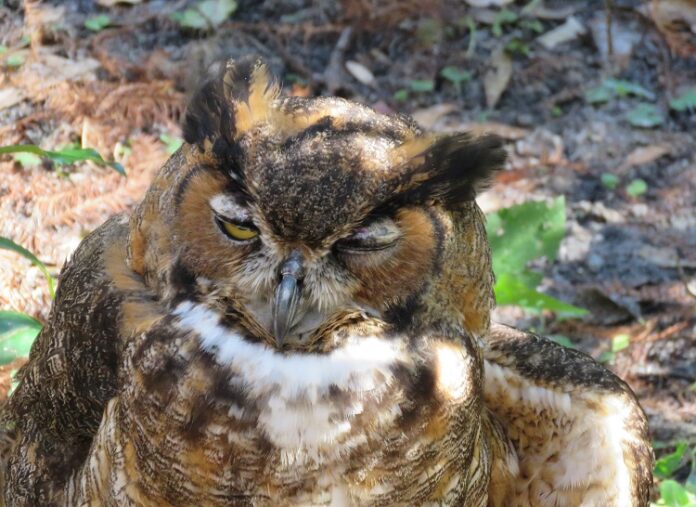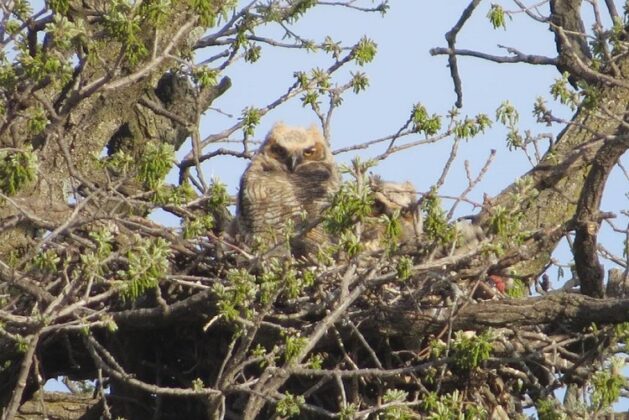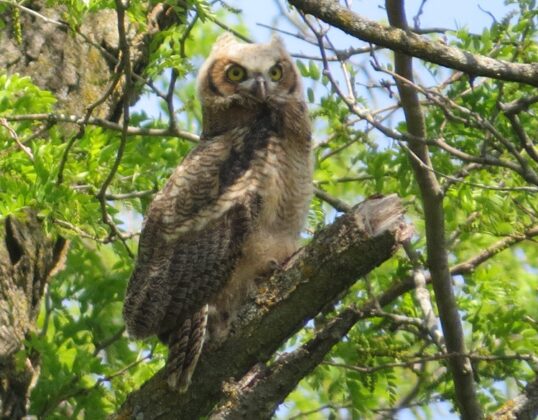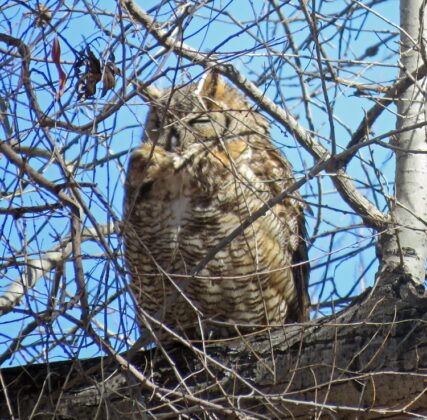I was awakened with a loud “Who-who-whooo” coming from the trees outside my bedroom window. It was the great horned owl’s mating call right on schedule.
Their calling begins in December and can continue through early February. Owls have made their courting calls from the large evergreen trees in my yard for many years. It is probably the same owl that was there in previous seasons because they seldom fly more that 50 miles from their birthplace.
The great horned owl is the most widespread of all species of owls. It is found across the North American continent wherever there is any woodland habitat. It is about two feet long and weighs three pounds, with a wingspan of nearly four feet.
Females are a little larger than the males, and the females tend to be a darker brown with more pronounced dark horizontal bars on their belly. Both sexes have a white bib of feathers under their chin.
They are one of the earliest nesting birds in Iowa. After mating, the eggs are laid in February and are incubated for 35 days. During the incubation period, the female remains on the nest while the smaller male hunts for their food.
When the babies hatch, both parents feed them for two months or more. By April the babies are big enough to fly, and by August they are hunting on their own. Sometimes during summer nights, the young owls can be heard giving a loud squawking like call, begging for their parents to feed them. The young owls stay near their parents until fall. They do not become sexually mature until they are two years old.
Horned owls do most of their hunting in the evening, feeding on mice, rabbits, birds, frogs and even fish, and they are one of the few animals that will eat a skunk because they have a very limited sense of smell. The non-digestible parts of its food are regurgitated in the form of pellets. These pellets are often used in biology classes for students to learn about food chains.
The owl is a silent hunter as it flies through the air. Tiny comb like teeth on the leading edge of its wing feathers and the fuzzy upper surface of the wing muffles sound. Its talons are strong enough to crush the skull of a rabbit, and the bird’s outer toe can pivot from front to back to allow the owl to get a strong grip on its prey.
The great horned owls are doing very well in Iowa. The population numbers have increased after the banning of the pesticides DDT and Dieldrin. Adult owls have no predators, but they are frequently harassed by crows and blue jays.
The greatest danger to owls is the automobile. The owls hunt the mice that live in grassy roadside ditches and when they swoop down to get a mouse, they are often hit by cars. A threat to baby owls is disease they get from their dirty nest. Most birds keep their nest clean, but not owls. They allow the uneaten remains of the prey to accumulate in their nest.
Humans have always been interested in owls. Their images can be found on many household items, pictures and figurines today, and even in ancient times people have been fascinated with owls. The Greeks associated them with Athena, the goddess of wisdom, and had the figure of an owl on one of their coins. The Egyptians mummified owls and put them in the tombs with their dead kings.
The great horned owl is an important link in the food chain. They are birds of prey that help keep rodent populations in check. Today ecologists see no threat to the great horned owl population, and they are a protected species. They are about as plentiful as the red-tailed hawk and like the hawk, owls are very adaptive to changes in the environment. I am sure that I will continue to hear their winter mating call outside my bedroom window for many years to come.





















There was all this talk last week about the Supurb owl.
It’s nice to finally see one.